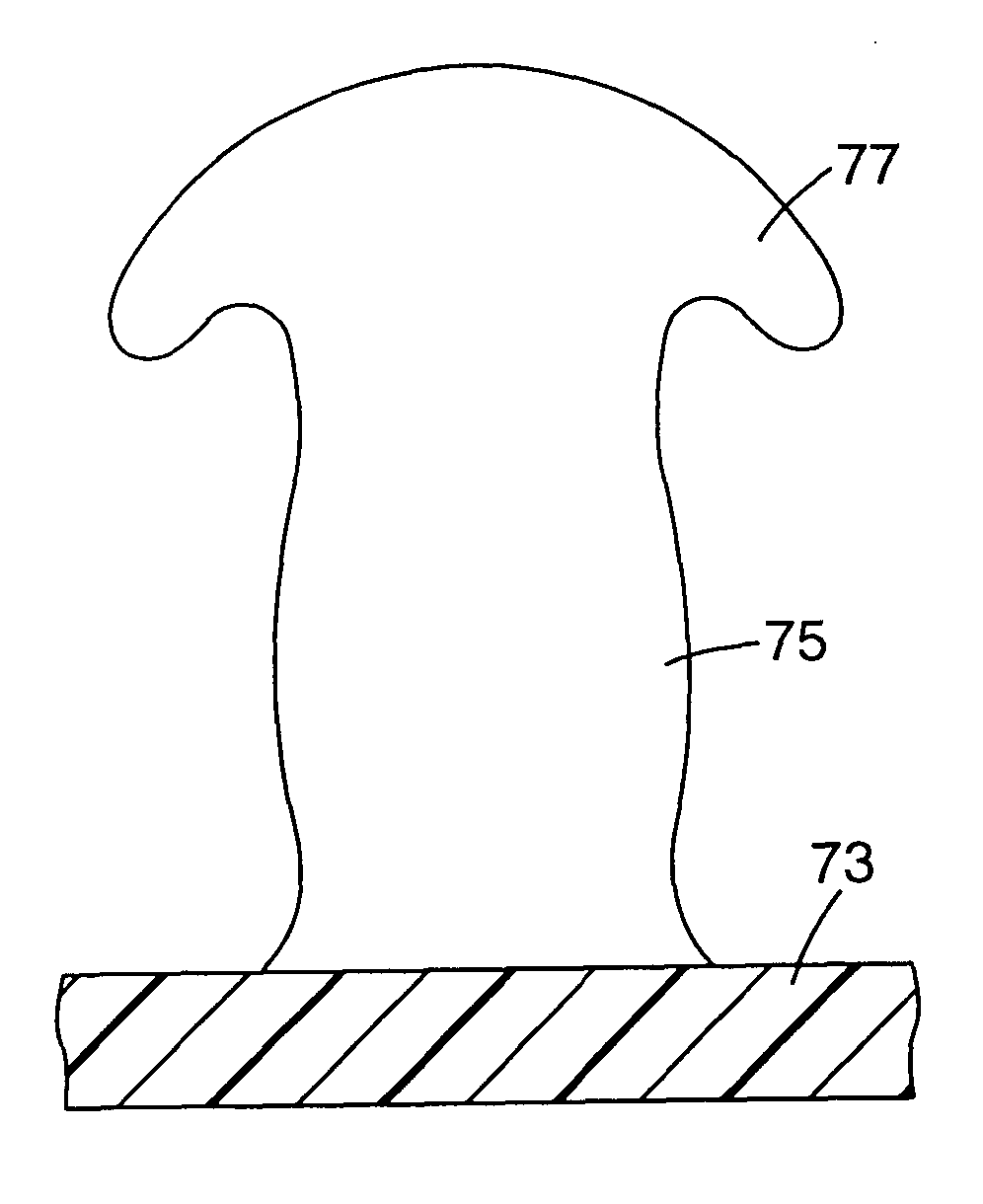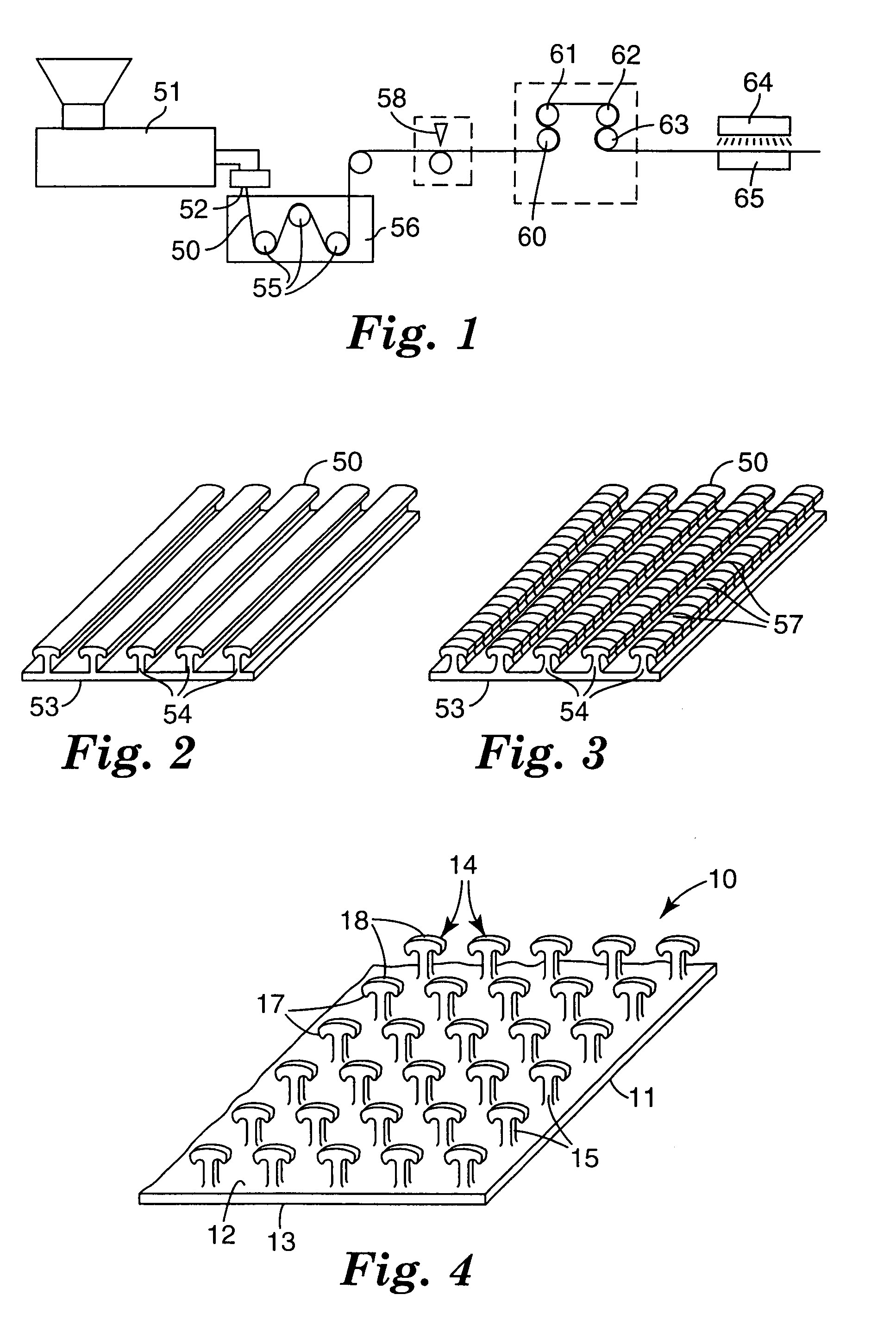[0005] An alternative direct molding process is proposed, for example, in U.S. Pat. No. 4,894,060, which permits the formation of hook elements without these limitations. Instead of the hook elements being formed as a negative of a cavity on a molding surface, the basic hook cross-section is formed by a profiled
extrusion die. The die simultaneously extrudes the film backing and rib structures. The individual hook elements are then formed from the ribs by cutting the ribs transversely followed by stretching the extruded strip in the direction of the ribs. The backing elongates but the cut rib sections remain substantially unchanged. This causes the individual cut sections of the ribs to separate each from the other in the direction of elongation forming discrete hook elements. Alternatively, using this same type
extrusion process, sections of the rib structures can be milled out to form discrete hook elements. With this profile extrusion, the basic hook cross section or profile is only limited by the die shape and hooks can be formed that extend in two directions and have hook head portions that need not taper to allow extraction from a molding surface. This is extremely advantageous in providing higher performing and more functionably versatile hook structures. However, a limitation with this method of manufacture is in forming hook structures that are extremely narrow in the extrusion direction of the ribs or the cut direction.
Cutting the formed ribs at very closely spaced intervals is difficult at commercially acceptable production speeds. Further, when the cut length is extremely closely spaced the previously cut portions of the ribs tend to fuse due to the heat created by the cutting operation. As such, there is a need to improve this process so as to allow for production of narrower hook profiles and formation of the narrower hook profiles at commercially acceptable production speeds.
[0007] The
fastener is preferably made by a novel
adaptation of a known method of making hook fasteners as described, for example, in U.S. Pat. Nos. 3,266,113; 3,557,413; 4,001,366; 4,056,593; 4,189,809 and 4,894,060 or alternatively 6,209,177, the substance of which are incorporated by reference in their entirety. The preferred method generally includes extruding a
thermoplastic resin through a die plate which die plate is shaped to form a base layer and spaced ridges, ribs or hook elements projecting above a surface of the base layer. These ridges generally form the cross-section shapes of the desired projection to be produced, which is preferably a hook member. When the die forms the spaced ridges or ribs the cross sectional shape of the hook members are formed by the die plate while the initial hook member thickness is formed by transversely cutting the ridges at spaced locations along their lengths to form discrete cut portions of the ridges. Subsequently longitudinal stretching of the backing layer (in the direction of the ridges on the
machine direction) separates these cut portions of the ridges, which cut portion then form spaced apart hook members. The extruded hook members or cut rib hook members are then
heat treated resulting in shrinkage of at least a portion of at least the hook head portion thickness by from 5 to 90 percent, preferably 30 to 90 percent. In an alternative embodiment, the heat treatment is continued to likewise shrink at least a portion of the stem portion of the hook members. The resulting heat treated projections, preferably hooks, are substantially upstanding or rigid such that they do not droop toward the base layer or are able to penetrate a fibrous or like substrate. In a particular preferred embodiment, the extruded thermoplastic resin contains an immiscible phase to increase the extent of molecular orientation in the
thermoplastic polymer or increase the degree of hook member or projection shrinkage when heat treated.
[0031] After cutting of the ribs 54, the base 53 of the strip 50 is longitudinally stretched at a
stretch ratio of at least 2 to 1, and preferably at a
stretch ratio of about 4 to 1, preferably between a first pair of nip rollers 60 and 61 and a second pair of nip rollers 62 and 63 driven at different surface speeds. Optionally, the strip 50 can also be transversely stretched to provide biaxial orientation to the base 53. Roller 61 is preferably heated to heat the base 53 prior to stretching, and the roller 62 is preferably chilled to stabilize the stretched base 53. Stretching causes spaces between the cut portions 57 of the ribs 54, which then become the hook portions or members 14 for the completed hook
fastener portion 10. The formed hook members are then heat treated preferably by a non-
contact heat source 64. The temperature and duration of the heating should be selected to cause shrinkage or thickness reduction of at least the head portion by from 5 to 90 percent. The heating is preferably accomplished using a non-contact heating source which can include radiant, hot air,
flame, UV,
microwave, ultrasonics or focused IR heat lamps. This
heat treating can be over the entire strip containing the formed hook portions or can be over only a portion or zone of the strip. Or different portions of the strip can be heat treated to more or less degrees of treatment. In this manner, it is possible to obtain on a single strip hook containing areas with different levels of performance without the need to extrude different shaped rib profiles. This heat treatment can change hook elements continuously or in gradients across a region of the hook strip. In this manner, the hook elements can differ continuously across a defined area of the hook member. Further, the hook density can be the same in the different regions coupled with substantially the same film backing caliper or thickness (e.g., 50 to 500 microns). The caliper can easily be made the same as the hook strip will have the same basis weight and same relative amount of material forming the hook elements and backing in all regions despite the difference in the shape of the hooks caused by the subsequent
heat treating. The
differential heat treatment can be along different rows or can cut across different rows, so that different types of hooks, such as hooks having different hook thicknesses, can be obtained in a single or multiple rows in the
machine direction or the lengthwise direction of the hook strip. The heat treatment can be performed at any time following creation of the hook element, such that customized performance can be created without the need for modifying the basic hook element manufacturing process.
[0035] The heat treatment is generally carried out at a temperature near or above the
polymer melt temperature. As the heat gets significantly above the
polymer melt temperature, the
treatment time decreases so as to minimize any actual melting of the
polymer in the hook head portion or top of the projection. The heat treatment is carried out at a time sufficient to result in reduction of the thickness of the hook head, and / or stem, but not such that there is a significant deformation of the backing or melt flow of the hook head portion or top of the projection. Heat treatment can also result in
rounding of the hook head portion edges, improving tactile feel for use in garment applications.
[0036] Unexpectedly it has been discovered, that for high performance microhook engagement with certain low cost or low loft loop fabrics, that this heat treatment substantially increases engagement of the microhooks to the loop fabrics. A particularly preferred novel, microhook member producible by the invention method has been discovered where the hook members have a height of less than 1000 .mu.m, preferably from 300 to 800 .mu.m, and at least a head portion with a thickness of from 50 to 200 .mu.m, preferably 50 to 180 .mu.m. The other dimensions for this improved microhook include a stem width, as defined above, of from 50 to 500 .mu.m, a head portion width of from 100 to 800 .mu.m, and an arm droop of from 50 to 700 .mu.m, preferably 100 to 500 .mu.m, and a hook density of at least 50 and preferably from about 70 to 150, up to 300, hooks per
square centimeter. This novel microhook hook portion exhibits improved overall performance to a variety of low loft loop fabrics.
[0044] When the extrudate exit temperature is at or below 50.degree. C. above the T.sub.m of the thermoplastic resin, the increase in T.sub.m of the resin as the
blowing agent comes out of the solution causes
crystallization of the thermoplastic resin, which in turn arrests the growth and coalescence of the foam cells. When exit temperatures are in excess of 50.degree. C. above the T.sub.m of the thermoplastic resin, cooling of the resin may take longer, resulting in non-uniform, unarrested
cell growth.
 Login to View More
Login to View More 


